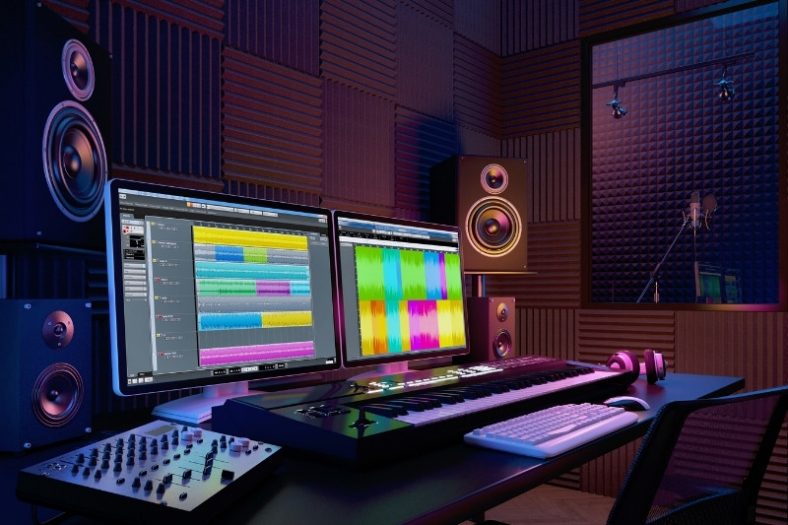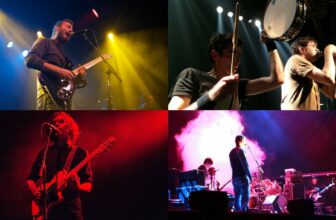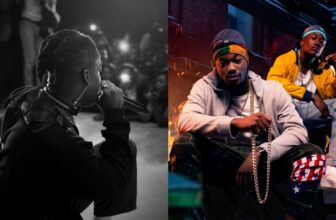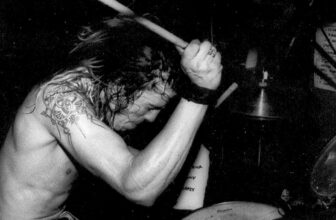What is Trap Music?

Trap music is a subgenre of hip-hop that originated in Atlanta in the late 1980s and became popular worldwide in the 2010s. It’s characterized by its minimal beats featuring complex hi-hat patterns and tuned 808 kick drums, lyrical content focused on gangsta-rap themes, and mumbled autotuned vocals.
For decades, trap music was mainly an underground movement in the Southern United States. The word “trap” is a slang term used in cities such as Atlanta to describe a house that sells illegal substances exclusively. It has been associated with the subgenre ever since the American rapper T.I. released his 2003 album “Trap Muzik.”
From the early 2010s onwards, trap music broke into the mainstream and influenced pop artists as famous as Rihanna, Beyoncé, and Miley Cyrus. Today, it’s perhaps the most recognizable subgenre of hip-hop in the world and is popular in and outside the United States.
Contents
What does Trap Music sound like?
Like all genres of music, trap music changed throughout the years. However, the subgenre stabilized in the aftermath of its 2010s popularity boom. These are the main musical and lyrical elements that characterize trap music.
- Tuned drums – The tuned 808 kick drum is the defining element of a trap beat and it’s often tuned to function as the bass (playing an actual hook or melody). The 808 kick drums used in trap beats generally have a long sustain and a powerful transient. However, trap beats also rely heavily on tuned hi-hats that play complex patterns throughout the song. The hi-hat pattern tends to be the most dynamic element in a trap beat.
- Minimal beats with little to no melody – While many trap beats feature a repetitive arpeggio (usually sampled and playing a minor-scale progression), most trap beats are incredibly minimal and rely solely on the bass (made mostly out of tuned 808 kick drums) and additional percussive elements.
- Fast BPM and slow underlining grooves – Most sources agree that trap beats are played at around 140 beats per minute (BPM). The high BPM helps trap producers come up with fast hi-hat patterns while maintaining an underlining groove (usually accentuated by a clap or trap snare) that often plays at a slower tempo of 70 BPM.
- Mumbled autotune vocals – While mumble rap and autotune haven’t been a core element of trap music from the very beginning, they’re now an indissociable part of the subgenre. Most popular trap artists sing with purposely poor diction, which can make the lyrics hard to understand (especially for non-English natives). The use of autotune in the vocals is also extremely prominent in trap music.
- Gangsta rap themes – Lyrically, trap music tends to focus on urban topics that are also explored in hip-hop subgenres such as Gangsta rap. Drugs (and drug-selling in particular) are one of the core subjects in trap music, but themes like violence, money, consumerism, and sex are also commonly explored in the subgenre.
- Extensive use of ad-libs – An ad-lib is a short vocal phrase or melody that’s added to the main verses of a song. Ad-libs are usually performed not by the main rapper (unless he or she is overdubbing) but by a second rapper or hype-man. While most forms of hip-hop feature ad-libs, the autotuned, screamy, and highly noticeable ad-libs used in trap music are very distinctive of the subgenre.
Is all Trap Music the same?
Trap music can be described as a fairly homogeneous subgenre, but that’s not to say that all trap music sounds the same. The style of beats and rapping changes from artist to artist and there are many different vibes in trap music, from the distorted “lo-fi-ness” of XXXTentacion to the country-inspired chorus of “Old Town Road.”
Needless to say, trap music changed drastically from its early days of obscureness in Atlanta to its current radio-friendly format. To better understand how trap music has become trap music, it’s important to learn more about its evolution.
The Evolution of Trap Music
Trap music is often seen as a new subgenre of hip-hop that emerged at the start of the 2010s. However, the seeds that would grow into becoming worldwide trap hits were planted in the city of Atlanta more than forty years ago, in the late 1980s.
The “before” of Trap Music
Atlanta, Georgia: in the late 80s and throughout the 90s, the American city had a fertile but relatively unknown underground hip-hop scene that counted with the likes of T.I., Lil Jon, DJ Paul, and Mannie Fresh. Many of these artists were depicted as being similar not only because of their physical proximity but also because of their constant exploration of drug-related themes.
This was the “before” of trap music. While UGK’s “Cocaine In The Back Of The Ride” (for example) doesn’t sound like a modern-day trap record, it already featured many of the traits that would help to shape trap music in its more concrete form. I believe that the Complex journalist David Drake summed early trap music best when he stated that it wasn’t a subgenre, but rather “a real place.”
The Rise of the Drug Dealer Rapper
Throughout the 2000s, trap music was somewhere in between being a real genre and a “real place.” No longer exclusive to the city of Atlanta and neighboring urban areas, the slang word “trap” and the figure of the drug-dealer rapper hit the mainstream in the United States.
In 2003, T.I. released the aforementioned “Trap Muzik” while the likes of Lil Wayne, Rick Ross, and Gucci Mane reached millions of hip-hop fans with their brand of drug-related rap performed over homemade beats that were often produced in a DAW instead of a turntable or MPC-style sampler.
Nowadays, listening to songs that Lil Wayne or even T.I. have put out in the 2000s doesn’t feel like listening to trap music. But without these pioneering artists, we wouldn’t have Future, Migos, or Travis Scott.
The popularity boom of Trap Music
Trap music spent the vast majority of the 2000s “in the oven” but came out as a fully-cooked meal ready to be enjoyed by millions of listeners. There are two seminal hit singles based on the popularity boom of trap music in the 2010s: Young Jeezy’s “Ballin” (featuring Lil Wayne) and ILoveMakonnen’s “Tuesday” (featuring Drake).
In a way, these two hit songs created the basis on which all future trap music would be set. Young Jeezy’s “Ballin” was a hard-hitting gangsta-inspired hip-hop track with a complex hi-hat pattern, while ILoveMakonnen’s “Tuesday” was an autotuned, repetitive, and slightly mumbled pop-rap hit over a high-definition tuned-808 bass melody.
While completely different, both hit singles were “remixed,” recombined, reinvented, and repurposed by most of the popular trap artists who followed.
Quintessential Trap Music Artists
While artists such as T.I., Lil Wayne, Drake, and even Kendrick Lamar deserve to be credited as some of the most important rappers in the history of trap, I tried to focus mostly on artists that are trap music through and through and that helped to further popularize the subgenre in the 2010s.
Gucci Mane
As one of the self-proclaimed inventors of trap music, Gucci Mane needed to be featured on our list of quintessential trap music artists. It’s not like he was making textbook trap songs before anyone else, but he did embrace them once the subgenre became popular. For a classic trap-music song performed by Gucci Mane, check out “Serial Killers.”
Future
When Future first came onto the scene, old-school hip-hop fans were baffled that such a “technically limited rapper” (not my words) could have had so much success. The fact is that, while Future isn’t delivering fire bars after fire bars in the style of Logic or Eminem, he got more than 500 million views on YouTube with his signature song “Mask Off.”
Most importantly, Future was the trap rapper responsible for popularizing the style of mumble rap that would later become prominent in the subgenre.
Travis Scott
Set over a traditional arpeggiated trap beat but featuring a contagious vocal melody and many hectic electronic details, Travis Scott’s “Goosebumps” (featuring Kendrick Lamar) is the perfect example of a trap song that broke the mold.
Often credited as the most inventive and successful trap artist in the world, Scott was the first man to prove that trap music could be more than a new version of Gangsta-rap for the masses. With records such as “Rodeo” and “Astroworld,” he showed there was more to the genre than drug stories and 808 kick drums.
Denzel Curry
Not nearly as famous as Travis Scott but equally acclaimed by music buffs, Denzel Curry is one of the artsiest trap rappers in the world. Based in Los Angeles, California, Curry created a new framework for trap music, one that doesn’t necessarily involve urban topics but rather a deeper and more metaphorical approach to trap lyrics.
Cardi B
The First Dame of trap music, Cardi B’s influence in the subgenre isn’t limited to the fact that she was the first major female trap artist in the world. More than that, she also proved that there was a place for classic, minimal, nasty, hard-hitting trap tunes on mainstream radio.
Lil Nas X
While some hip-hop fans may feel bad about it, there’s no denying that Lil Nas X’s unexpected hit song “Old Town Road” brought something new to the trap music scene. In a nutshell, Lil Nas X was the first successful artist to make “family-oriented” trap music.
As a result (and with some help from Billy Ray Cyrus) Lil Nas X released what was perhaps the first trap music that reached all audiences, in and outside of the world of hip-hop.
Conclusion
If hip-hop music is about attitude, then trap music IS real hip-hop. Putting old habits of hip-hop aside and valuing self-confidence over technical prowess, trap rappers won over the hearts of millions of fans and stormed the pop charts in and outside of the United States.
Today, this once-obscure subgenre is as recognizable as the Eiffel Tower and will surely continue to inspire new artists in the years to come.





